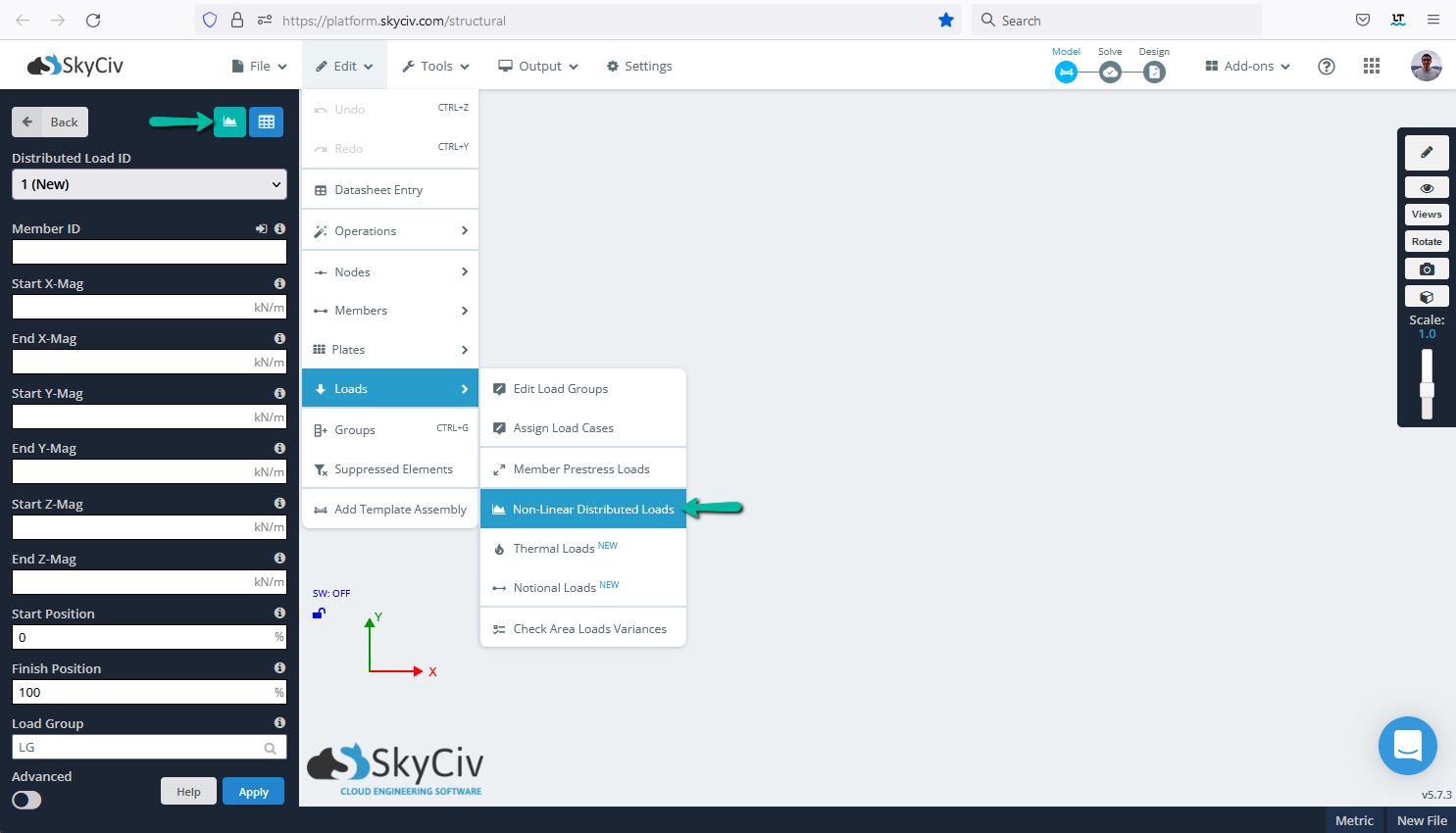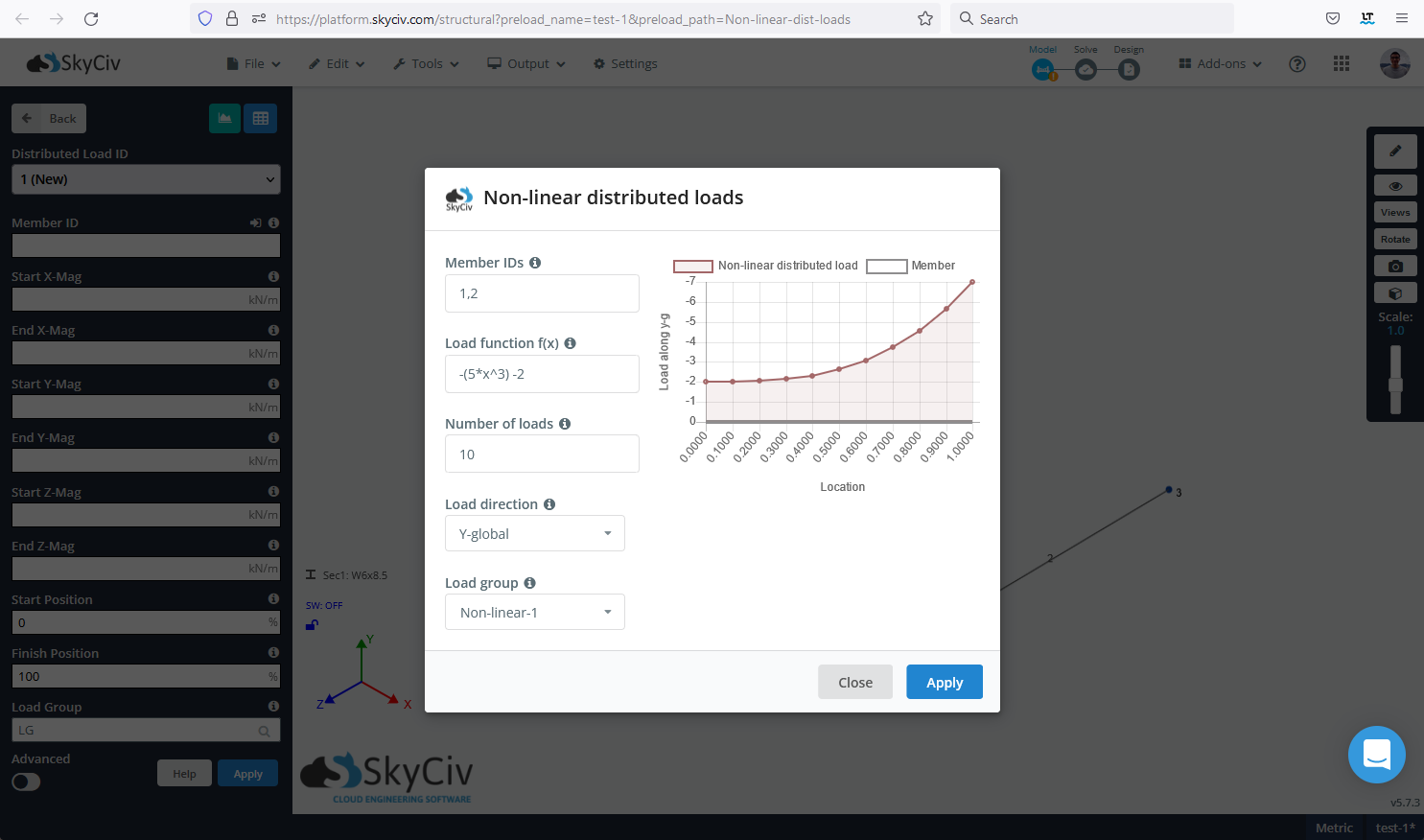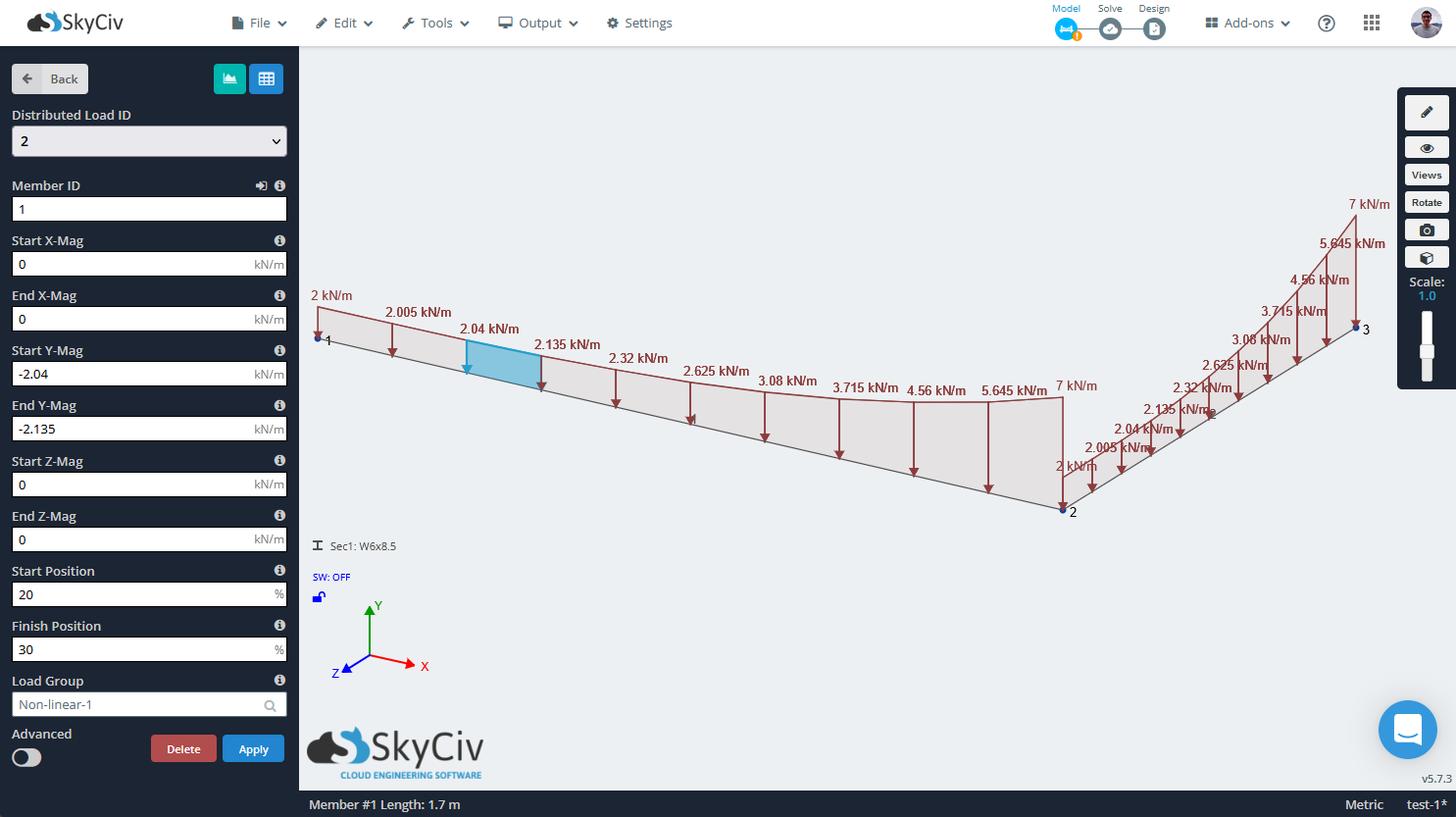Carichi distribuiti (DL di) sono forze che agiscono su una campata e sono misurate in forza per unità di lunghezza (per esempio. kN/m o kip/ft). Possono essere uniformi o non uniformi.
Applicazione di un carico distribuito
I DL vengono applicati a un membro e per impostazione predefinita si estenderanno sull'intera lunghezza del membro. Gli utenti hanno tuttavia la possibilità di specificare l'inizio e la fine del DL da qualche parte lungo l'intervallo.
I DL applicati ad angolo all'asta possono essere specificati fornendo la X ,E, componenti Z.
Per applicare un DL, vai al menu di input sul lato sinistro e fai clic su Carico distribuito pulsante. Gli utenti possono anche applicare una DL a un membro selezionando prima un membro, quindi fare clic con il pulsante destro del mouse e selezionare “Aggiungi carico distribuito”, che ti porterà al Carico distribuito schermata di immissione con il campo ID membro già compilato.
Quando si applica il DL, gli utenti devono specificare i valori per:
- ID carico distribuito – L'ID numerico utilizzato per identificare ogni DL.
- ID membro – Il membro a cui viene applicato il DL.
- Avvia X-Mag – La grandezza iniziale del DL – questo può essere sia nella direzione X globale, o la direzione X locale dell'asta modificando il punto di riferimento dell'asse.
- Fine X-Mag – La grandezza finale del DL – questo può essere sia nella direzione X globale, o la direzione X locale dell'asta modificando il punto di riferimento dell'asse.
- Avvia Y-Mag – La grandezza iniziale del DL – questo può essere sia nella direzione Y globale, o la direzione Y locale dell'asta modificando il punto di riferimento dell'asse.
- Fine Y-Mag – La grandezza finale del DL – questo può essere sia nella direzione Y globale, o la direzione Y locale dell'asta modificando il punto di riferimento dell'asse.
- Avvia Z-Mag – La grandezza iniziale del DL nella direzione Z – anche in questo caso può essere Local Z o Local Z del membro, dipende da minore ambientazione.
- Fine Z-Mag – La grandezza finale del DL nella direzione Z – anche in questo caso può essere Local Z o Local Z del membro, dipende da minore ambientazione.
- Posizione di partenza – La posizione lungo il membro in cui inizia il DL. Espresso come a %. predefinito = 0%
- Posizione finale – La posizione lungo l'asta in cui termina il DL. Espresso come a %. predefinito = 100%
- Carica gruppo – I carichi possono essere raggruppati con i numeri del gruppo di carico. I gruppi di carico possono quindi essere moltiplicati per un fattore in "Combinazioni di carico’ menù. Opzionale.
Impostazioni avanzate
- Assi – Applicare il DL lungo il globale (predefinito) o asse locale. Se Locale, può essere utile attivare il Mostra Asse locale membro ATTIVO nelle impostazioni di visibilità, in modo che gli utenti possano vedere l'asse di riferimento.
Esempio:
Ecco un esempio in cui il carico distribuito ha una magnitudine iniziale Y di -10kN/m e una magnitudo Y finale di -30kN/m. Ha anche un file 20% posizione di partenza e un 80% posizione finale – mostrando che non si estende per l'intera campata del membro, ma piuttosto inizia 20% dal nodo iniziale e finale (1 e 2 rispettivamente).
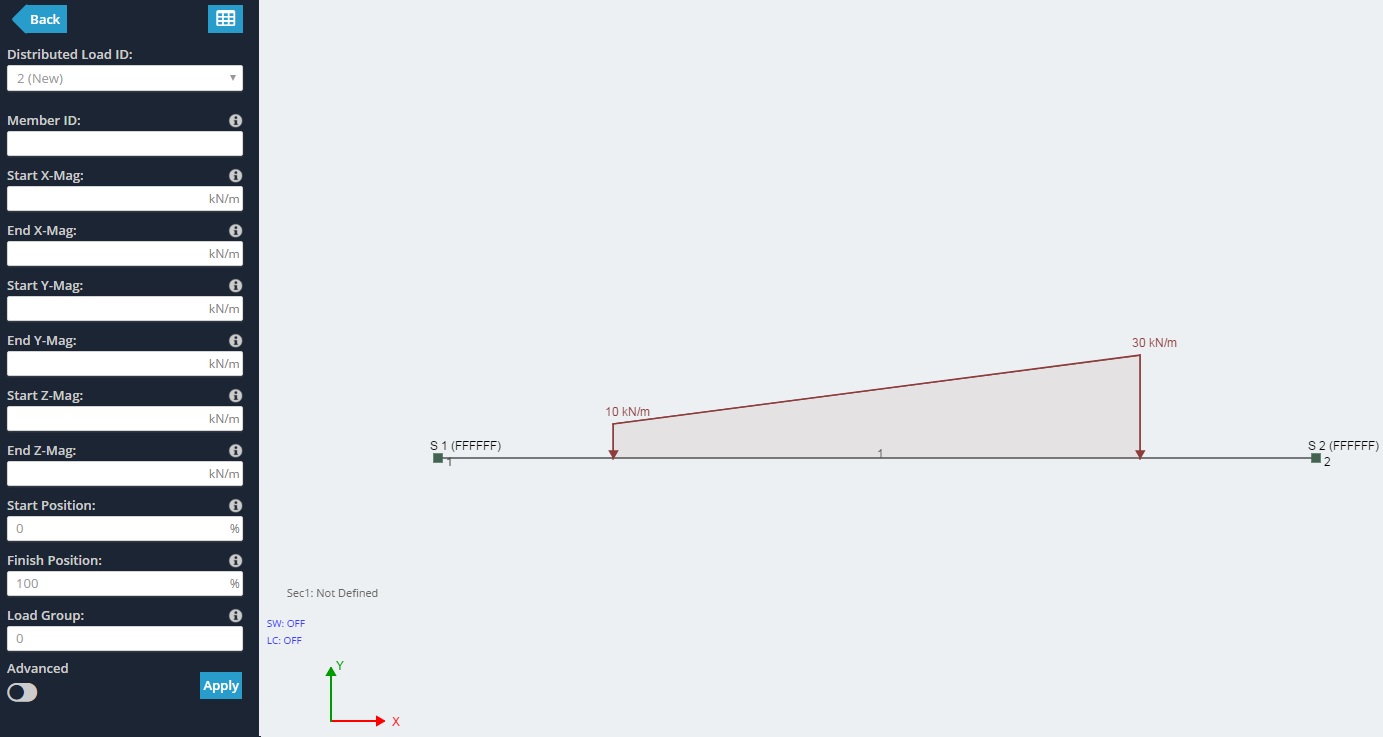
Assi locali/globali
Asse globale
Ecco un esempio di dove membro 3 ha un carico distribuito di 100kN/m applicato al suo Globale asse. Possiamo vedere che la forza qui viene applicata direttamente nella Y globale (giù).
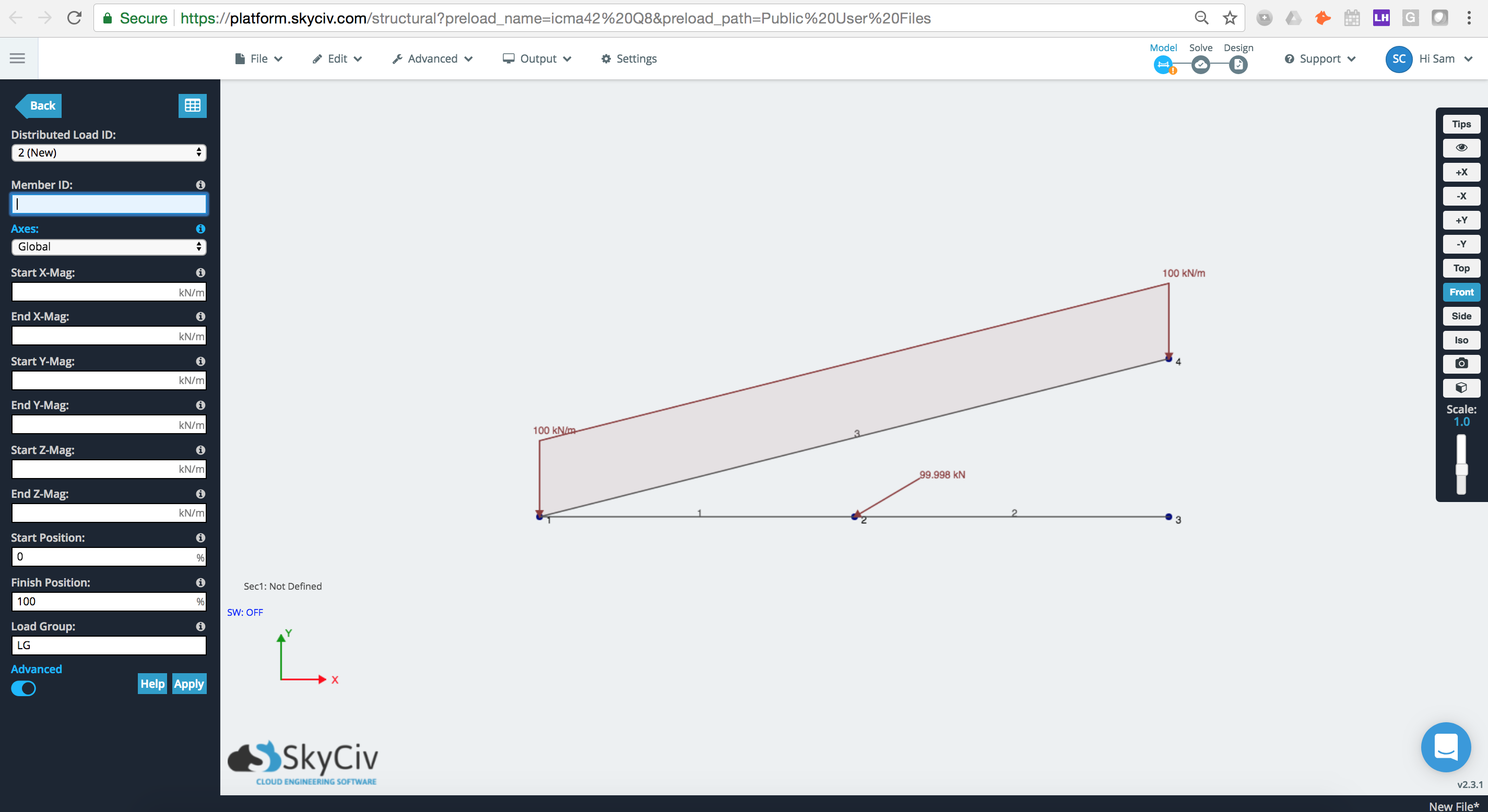
Asse locale
Se cambiamo l'opzione degli assi in Locale possiamo vedere che il carico distribuito è stato ora applicato all'asse locale del membro, dove Y locale è direttamente perpendicolare all'asta.

Applicazione di un carico distribuito non lineare
A volte carichi distribuiti (DLs) sugli elementi di una struttura seguono una distribuzione speciale che non può essere idealizzata con una sola costante o anche con un carico distribuito lineare non uniforme, e quindi sono necessari carichi distribuiti non lineari. Per quei casi, è possibile aggiungere un carico distribuito, la cui distribuzione è definita da una funzione in termini di posizione lungo l'asta.
Per applicare un DL non lineare o definito da un'equazione, vai al menu di input sul lato sinistro e fai clic su Carico distribuito pulsante, quindi fare clic sul pulsante Aggiungi carico distribuito non lineare. Gli utenti possono anche accedere a quel menu navigando nella barra in alto a modificare > Carichi > Carichi distribuiti non lineari
Quando si applica il DL non lineare o definito dall'equazione, gli utenti devono specificare i valori per:
- non è necessario identificare la direzione della campata: ID separati da virgola delle aste per applicare il carico distribuito non lineare o definito dall'equazione. È possibile selezionare i membri prima di aprire la finestra, e il campo di input verrà compilato automaticamente.
- Funzione di caricamento: Funzione o equazione in termini di posizione lungo l'asta (x) che definisce l'entità del carico. La lunghezza dei membri è normalizzata, scappando da 0 per 1.
- Numero di carichi: Rappresenta il numero di carichi distribuiti lineari che il software utilizzerà per approssimare la funzione di input.
- Direzione del carico: Come per carichi distribuiti uniformi e non uniformi, il carico può essere applicato nel sistema coordinato locale o globale.
- Gruppo di carico: Nome del gruppo a cui aggiungere il carico distribuito non lineare che verrà creato. Per impostazione predefinita, il software creerà un nuovo gruppo di carico, ma è possibile selezionare un gruppo di carico esistente o rinominare quello nuovo.
Dopo aver inserito correttamente tutti i valori richiesti, il carico distribuito non lineare o definito dall'equazione verrà aggiunto alle aste selezionate, se i risultati non sono quelli attesi è sempre possibile annullare le modifiche e riprovare. Come menzionato prima, la funzione di ingresso è approssimata da un numero di carichi distribuiti lineari, puoi trovarli tutti come normali carichi distribuiti.

